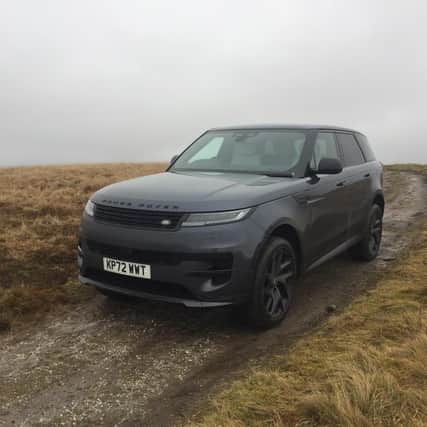Range Rover Sport: my week with an understated hero of the roads


Land Rover sales are up. The new Defender has given the nation’s favourite 4x4 maker a brighter future, albeit usurping the appeal of its older sibling, the Discovery. That’s the one with the offset rear number plate, in case you don’t follow such things.
Defenders will go anywhere but are not cheap if all you want is something to tow livestock and get muddy on the farm, the way they once were. Most Defenders are being bought by town and country types, one might suspect as an alternative to an equally expensive German car or indeed other Land Rover products, to whit, the Discovery.
Advertisement
Hide AdAdvertisement
Hide AdThree in four Land Rover orders are for the Defender and the new Range Rover and Range Rover Sport launched last year. These Range Rovers get better as the decades pass, and more expensive. The latest design reduced the fatuous excess of body styling gimmickry. It really is smart without being showy.
The Range Rover per se has a very distinguished back, with slim vertical rear lights, recursive of big American SUVs. That, and its bulk, separates it from the Range Rover Sport tested here, which has a lower roof line and sportier styling. We took it to the city and we took it to the motorway and to the shops and a leisure centre and to Alf the horologist, still happy with his Mazda.
It mingled with the general population, who usually looked twice at the relative newcomer. On a roundabout it gave way to a Rolls-Royce Cullinan, vastly more expensive and hinting at a higher tier of status, do we think, with that historic front?
The Sport acquitted itself well. With a maximum ride height of 10 to 11 inches on its air suspension, and a variety of traction settings, and of course permanent all-wheel-drive, ground-viewing cameras, immense engine power and low ratio gears not much you’d sensibly tackle will stop it. Were you to make a habit of such forays then a more aggressive tyre tread is advisable. The test car was riding and gripping well enough on Pirelli Scorpion all-season tyres.
Advertisement
Hide AdAdvertisement
Hide AdWith a massive 285 width they were quiet and secure. The unsprung heft of the 22-inch alloys no doubt contributed to rather too much rumble and resonance — at least more than I expected.
Moving swiftly on, the large car was easy to drive and use. There is comfortable room for five. The furnishings are smart and calm, lovely. So, there is plenty of piano black, setting off the light hue of the leather. A large central screen dominates the view, with touch sensitive pads and control dials below for the ventilation, breathing out through a slim lateral duct. The stitched leather steering wheel joins could have been neater.
There is a lot of understatement and plenty of storage options. A glass roof lets in light. The back, the place to ride, is a serene setting with a wide drop-down divider which contains a storage tray and slick-moving pop-out cupholders. Electric buttons adjust the seat angle.
A Range Rover Sport is also a handy load hauler. Inside the tailgate, electric switches fold down the back seats, giving a load length of nearly six feet and 40 inches between the arches — just a fit for a 1.8m x 0.8m fence panel for the garden. Electric power returns the heavy seats to normal.
Advertisement
Hide AdAdvertisement
Hide AdThe first Range Rover Sport came in 2005, as a rebodied version of the Discovery, with a steel body. The replacement in 2013 was based on the Range Rover and got an aluminium body on a monocoque chassis — lighter and more refined. In 2018 they gave us the SVR model, with 567 bhp and racetrack speeds. I reached 150mph on a runway.
Prices for the new Sport start at £80,325 for the SE with a 3-litre mild hybrid 296bhp diesel engine, the D300. A 345bhp D350 version costs from £99,245 in plushest Autobiography trim, a £4,180 hike over the D300 Autobiography. A mild hybrid P400 3-litre petrol engine with 395bhp costs from £87,395.
Businesses will want the plug-in hybrid 3-litre twin turbo, in 434bhp and 503bhp tune. The ratified CO2 ratings of 19g/km give huge payroll tax savings and up to 70 miles of electric range. SE PHEV prices start at £84,530.
With a full battery, driven in petrol/electric hybrid mode, we got 55 miles a gallon. When the battery was drained this was halved. The dashboard gave me an 80 per cent efficiency score. (Company ratings for the diesel engines are 37mpg and 198g to 203g, and 30mpg/219g for the P400 petrol model.)
Advertisement
Hide AdAdvertisement
Hide AdPerformance always remained impressive, making the Sport a rapid luxury tourer, ready for driving pleasure. In time my muscles got used to operating the heavy doors.
________
Range Rover Sport Dynamic SE 440hp PHEV, from £87,475. All-wheel-drive, adaptable air suspension, terrain response traction control, eight-speed automatic gearbox on all models. Twin turbo as tested delivers 434bhp and 457 lb ft of torque giving 0-60mph in 5.5 seconds and 140mph.
Economy: rated at 334mpg and 19g/km CO2. On test, 25 to 55mpg. Size: 195 inches long (4.9m) and 80 inches wide. Kerb weight 2.7 tons. Towing: 3 tons. Made in Solihull, West Midlands.
Other Sport models from £80,325 with a sample monthly PCP of £1,047.
Or: The Range Rover from £99,375.
More: 0370 5000500 & landrover.co.uk
Comment Guidelines
National World encourages reader discussion on our stories. User feedback, insights and back-and-forth exchanges add a rich layer of context to reporting. Please review our Community Guidelines before commenting.